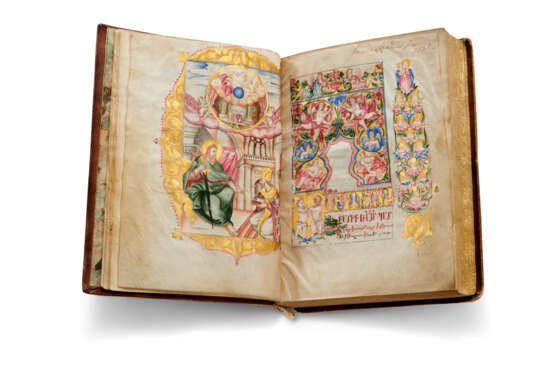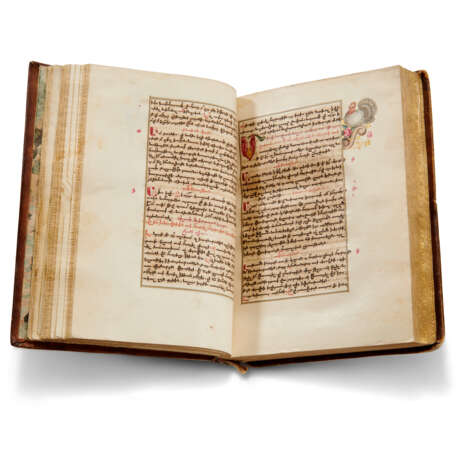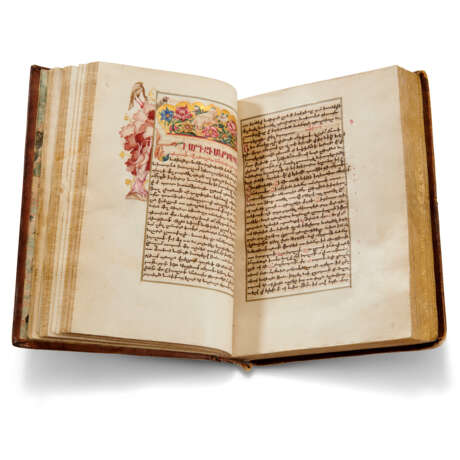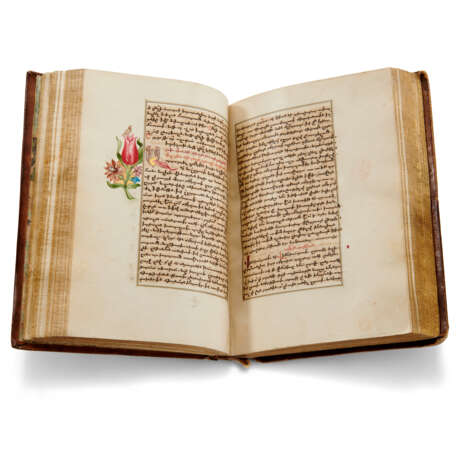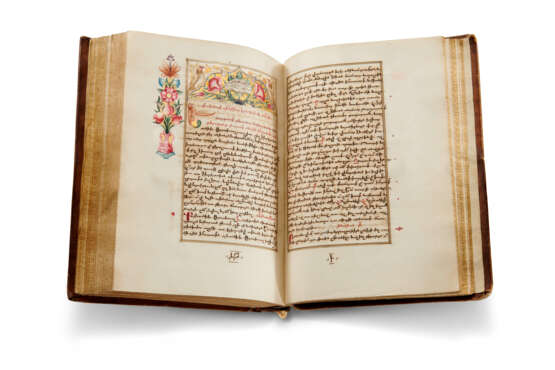ID 794555
Lot 48 | Pseudo-Dionysius (author); Barsegh and Yakob Sebastats’i (illuminators)
Estimate value
£ 12 000 – 18 000
Works attributed to Dionysius Areopagita (i.e., pseudo-Dionysius), in classical Armenian (grabar), illuminated manuscript on paper, Monastery of Ur?nka (or Ur?nkar), north of Lake Van, 1733.
A splendidly illuminated manuscript of the works of pseudo-Dionysius copied by the scribe Yohannes Baghishets’i, assisted by Petros, Astuastsatur and Nazar Sebastats’i (of Sebastia, now Sivas) and illuminated by the brothers Barsegh and Yakob Sebastats’i for Step’annos abegha (monk) Sebastats’i.
193 x 140 mm, 260 leaves, collation: 18, 2-2112, one column of 30 lines each, the text mostly notrgir (notary) script with some bolorgir (minuscule) and erkat’agir (majuscule) throughout, ruled space: c.138 x 83 mm, catchwords on every verso, includes one full-page illumination with a facing incipit page on a parchment bifolio (ff.4-5). The single columns are outlined by triple black and gold lines forming a box inside which the text was written (mostly at the beginning and end of the manuscript, these incised lines have enabled cracks to develop in many of the leaves, in some cases causing the part of the sheet inside the 'box' to almost detach from the page). Non-Armenian binding of dark brown leather decorated with gold tooling over pasteboard boards, including tooled board edges, gilt and gauffered fore-edges, spine lettered in gold: ????????? ????????? [DIONESIOS ARISPAGTS’I], i.e. Dionysius the Areopagite. Marbled paper pastedown and flyleaf with a second style of marbled paper forming a second flyleaf at both beginning and end of book.
Provenance:
(1) Step’annos abegha (monk) Sebastats’i: original patron from 1733.
(2) Khach’ik Mgrdchean, 1838: name inscribed at top of f.5.
(3) Given to Prince N. Amaduni by Melkon Balt’azarean, Baghdad 15 July 1904: inscription on f.4.
Content: Works attributed to Dionysius the Areopagite (aka pseudo-Dionysius): Heavenly Hierarchy, Ecclesiastical Hierarchy, Divine Names, Mystical Theology, Letters. Translated from the Greek into Armenian by Step’anos of Siunik’ in the 8th century.
This 18th-century manuscript consists of the Armenian translation of five works attributed to Dionysius the Areopagite. Long ago the author of these texts was conflated with a first-century Athenian saint named Dionysius the Areopagite. The author’s true identity has not yet been determined, but he is now known as pseudo-Dionysius, a Greek theologian who originally composed these works in the 6th century. His writings were first translated from the original Greek into Armenian in the 8th century by Step’anos of Siwnik’ in Constantinople. This Armenian translation was later reworked by another Step’anos (of Poland, i.e. Step’anos Lehats’i) in the 17th century who also used a Latin version for his translation. The corpus of works by pseudo-Dionysius had important theological and spiritual influences on various Armenian theological schools from the 10th to 15th centuries.
The continued creation of manuscripts in the 18th century, such as this one from 1733, may seem extremely late by European standards but was not at all uncommon in the Near East in East Christian, Jewish, and Islamic traditions due to the late introduction of the printing press to these regions. There was an unbroken tradition of manuscript production by Armenians, who continued many of their traditions in decoration and technique, although they were not immune to inspiration from their exposure to printed books. In this manuscript, they continue the long-time use of producing 'bird letters' for initial letters, which are formed by twisting one or more birds into the letter form. The first headpiece introducing the preface is painted using a typical Armenian medieval trilobed design surrounded by interlace.
Illumination:
The delicately painted floral, bird and insect marginal decorations are completely unrelated to the text and are included simply to embellish and beautify the book. In the 17th to 18th centuries, such motifs became popular in both late Armenian and Islamic manuscripts, and were possibly first introduced through exposure to imported western European printed herbal books. Most of the flower paintings in this manuscript also include some type of bird, not all of which we have identified. However, two grey turkeys (birds native to the New World but first brought to Spain in the 16th c. after which they were brought eastward), have been included, as well as many other birds which are presumably native to the region. The finesse and charm of these marginal flora and fauna are notable, and the two artists (the brothers Barsegh and Yakob Sebastats’i) are highly praised in the colophon.
F.4v, full-page illumination of an unidentified enthroned, bearded and haloed figure holding a sword (perhaps Dionysius?) pointing to a kneeling bearded figure wearing a gold bishop’s miter and ecclesiastical vestments holding a book (perhaps the receiver of the manuscript?) in a church setting. Above, two cherubs in clouds hold a sphere enclosing the Trinity, more clouds, and a blue orb in the upper portion, with two columns, chalice, dove, red heart, and a paten(?) depicted in the lower portion.
F.5: Large headpiece with gold background filled with 8 angels, and a profusion of flowers and leaves, marking the beginning of the first text (Heavenly Hierarchy), first line composed of Armenian bird-letters; right margin consists of 12 flowers from which spring 12 male busts with bishops’(?) miters, and torso of the Virgin holding the Christ Child emerges from a multi-petaled flower at the top.
Dozens of fine marginal illustrations throughout, highlighted with gold: birds (including two turkeys, a rooster, partridge, and many others), colourful flowers (tulips, carnations, roses, and others), butterflies, pomegranates, etc.
Traditional Armenian bird letters (birds twisted into the form of a initial letter) are found throughout.
A headpiece marks the beginning of the prologue and each text section, and including a large headpiece on the incipit page (f.5) plus 5 smaller headpieces:
1) Headpiece with traditional Armenian interlace design, f.2 (prologue);
2) Incipit page marking first page of Heavenly Hierarchy text, f.5v, as described above;
3) Headpiece with lamb of God frolicking in bed of flowers with gold background, indicating the beginning of Ecclesiastical Hierarchy;
4) Headpiece with birds, flowers, and pomegranates, marking the beginning of Divine Names;
5) Headpiece with large white rose and other flowers, and two birds in profile, marking the beginning of Mystical Theology;
6) Headpiece with large pink carnation(?) and other flowers, designating the beginning of Letters.
Christie's would like to thank Dr Sylvie Merian for her expertise in cataloguing this lot.
Literature
The Armenian Version of the works attributed to Dionysius the Areopagite, edited and translated by Robert W. Thomson, 2 vols. (Louvain: Peeters, 1987).
Arsen Harut’yunyan, 'XVIII dari erku norahayt dze?agir ev mi dze?ats’ khach’,' Banber Matenadarani 24 (2017): 209-221.
Sergio La Porta, 'The Reception and Influence of the Corpus of Works attributed to Dionysius the Areopagite in the Medieval Armenian Spiritual Tradition,' ARC, The Journal of the Faculty of Religious Studies, McGill University, 35 (2007): 211-226.
Sergio La Porta, 'Two Visions of Mysticism: The Corpus Dionysiacum and The Book of Lamentation,' Revue Théologique de Kaslik 3-4 (2009-2010): 243-257.
Robert W. Thomson, 'The Armenian Version of Ps.-Dionysius Areopagita,' Acta Jutlandia, 27 (1982): 115-124.
Special notice
No VAT on hammer price or buyer's premium.
| Place of origin: | Armenia, Asia |
|---|---|
| Auction house category: | Medieval & renaissance manuscripts |
| Place of origin: | Armenia, Asia |
|---|---|
| Auction house category: | Medieval & renaissance manuscripts |
| Address of auction |
CHRISTIE'S 8 King Street, St. James's SW1Y 6QT London United Kingdom | |
|---|---|---|
| Preview |
| |
| Phone | +44 (0)20 7839 9060 | |
| Buyer Premium | see on Website | |
| Conditions of purchase | Conditions of purchase |
